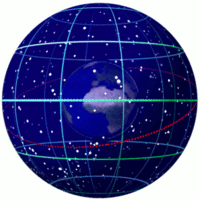Knowing How You Know/Tyranny of Evidence
Ever since humans first saw the sun rise in the morning, move across the sky, and set in the evening, the direct evidence has been clear and obvious: the sun circles the earth each day.[1] Similarly we see the stars move across the sky each night, and it is obvious they are attached to a celestial sphere that holds them up and also circles the earth. This Truth we can all plainly see. With more careful observation we notice that the sun rises earlier and sets later in the summer than in the winter. Perhaps the architects of Stonehenge wanted to celebrate the annual phases of this cycle with its shortest day, longest day and two equinoxes.

Ancient astronomers mapped the sky and catalogued the constellations making up the celestial sphere. However, they also noticed “the wanderers”—certain stars, some of which are particularly bright—that move against the backdrop of the celestial sphere. What are we to make of these direct observations, available to anyone willing to look up and notice the night sky? Perhaps these "wanderers", now called planets, have their own celestial sphere. But since they move in different patterns, maybe each has its own sphere. The astronomer Ptolemy worked this all out in some detail for us nearly 2,000 years ago. He even found a place in the heavens for the lovely moon.
Then about 400 years ago the astronomer Tycho Brahe dedicated his career to making the most accurate astronomical observations ever. These observations were inconsistent with planets moving in circles and provided evidence to support Kepler's discovery of the ellipse and area laws of planetary motion. Copernicus’s silly ideas about the earth circling the sun might be worth a second look!
In 1610 Galileo pointed his telescope toward the sky and directly observed the phases of Venus and the moons of Jupiter. He interpreted this evidence to support Copernicus’s heliocentric model and got in big trouble with Pope Urban VIII for speaking his mind based on the evidence he directly observed.
On July 5, 1687 Isaac Newton published the Principia where he stated his three laws of motion. He also defined the universal law of gravitation and used calculus-like mathematics to demonstrate how the laws of motion and universal gravitation combine to cause the planets to move in elliptical obits around the sun. The observations of Tycho Brahe were finally explained, except of course for the later discovery of additional planets, Einstein’s relativity, observations made by the Hubble telescope, and ongoing observations and evidence of our amazing universe. And what do we make of comets, eclipses, galaxies, and ocean tides?
We can now see these truths:
- Our direct observations are limited to what one person sees from one place at one time. I see the sun rise and set each day. It has happened each day I know of.
- We interpret each new observation to help explain or become consistent with other observations. The sun moves across the sky, it does not fall down, therefore it is held up by a celestial sphere.
- Interpretation is separate from and necessarily extends our direct observations. These interpretations require judgment.
- The scope of direct observation and deductive logic is very limited. We regularly rely on inductive logic to extend our conclusions beyond our direct observations. The sun has risen every day; I expect it to rise again tomorrow.
- We regularly supplement our own observations with those reported by others. Those reports may or may not be accurate. We may or may not fully understand them.
- We have to decide for ourselves how to assimilate observations reported by others. I can see the planets, and if I take the time I can notice they move against the background of stars. I’m not sure what to make of it, but let me learn what the astronomers, religious leaders, and my friends have to say about this. I may also consult the mainstream media, specialized journals and publications, conspiracy blogs, or Wikipedia.
- Observations become more extensive and refined over time. The skills of Tycho Brahe and Galileo eventually brought more evidence to the table.
- Evidence is often difficult to collect, difficult to interpret, and apparently contradictory. Available evidence increases over time.
- As we expand our circle of concern in space and time, we have more observations, evidence, and reports to assimilate, interpret, and reconcile.
- Long-held beliefs are difficult to overcome, despite contrary evidence. The Pope was not quickly convinced by what Galileo saw. On October 31, 1992, Pope John Paul II expressed regret for how the Galileo affair was handled.
- People make decisions and live their lives based on what they believe to be true. It is an on-going process.
- Each of us uses some form of “Theory of Knowledge” to decide what we believe in the face of complex and often conflicting evidence.
- Developing our own robust theory of knowledge helps us to choose the most reliably accurate beliefs.
- My own theory of knowledge is described in this essay on choosing my beliefs.
- Improving our theory of knowledge and applying it is the best we can do to move toward truth.
- I hold these truths to be self-evident!
Stay curious, look again, look deeper, look farther and enjoy exploring our amazing and dynamic universe.
Notes
[edit | edit source]- ↑ This essay first appeared as a blog post. It has been adapted here with permission of the author. See: http://theycallmelee.blogspot.com/2010/09/tyranny-of-evidence.html
